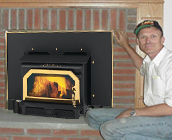Fireside
Formerly Wakefield Stove
JohnDebar@gmail.com
Fireside Online Located at  Phone: 401- 783-6054 Email: johndebar@gmail.com
Phone: 401- 783-6054 Email: johndebar@gmail.com 

52 Main St, Wakefield, RI.
 Phone: 401- 783-6054 Email: johndebar@gmail.com
Phone: 401- 783-6054 Email: johndebar@gmail.com 
-
Fireside Stove Shoppe
Amazing!
The flash combustion of smoke!
The flash combustion of smoke!
Wood Heating Performance Tips- Low Emission, Flash Combustion Stoves & Inserts
2- Wood can't be too dry. Fragile cast iron stoves (not yours) get damaged with dry wood. Your stove holds up to extreme temperatures fully dry wood delivers. Even though very dry wood heats more area and faster, dry wood is especially important to increase the likelihood smoke will burn on the lower setting. Fully seasoned wood triggers a host of benefits, such as longer and more efficient burn cycles, and thus a higher likelihood of '24/7' temp stability, as well as keeping the furnace off hours prior to waking up. To this, add a 'stay clean' chimney, cleaner glass, much less wood cost and work, and a clean burn to the extent of being carbon neutral. These benefits illustrate the benefits to obtaining 'seasoned' wood 8-12 months in advance of burning it, so it fully dries out. Partially seasoned wood can lead to odors from a cold chimney, when 'tight home' back-drafting
3- If odors/smoking occurs from the stove, factors are at play weakening the chimney's ability to draft properly, mostly when starting. To initialize the draft, ignite a single sheet of newspaper, without folding it tight. Unfolded, it will flare up quickly and go out in seconds. Repeat if necessary. This will lessen the cold heavy air in chimney, and get the smoke moving up and out faster. Try this with a window cracked open if smoking persists. Once the flue pathway is hot, shut the window. Note that home air leaving via the chimney, with the door open, is about 50 cubic feet /minute. This air going up the chimney needs to be supplied back into the home! Overly air tight homes fail in allowing enough volume of air back into the home to feed appliances that vent. New homes are now required, by code, to have an opening to supply the homes numerous vents, called, 'make up air'. New homes may have outside air piped directly to the furnace air intake, but it is necessary for tight homes to have another air intake feeding other vents using home air. Those cold drafts serve a function, and obsession with blocking them is harmful. Without enough outside air intake built into your home, make up air (with creosote odors), sucked in by other venting appliances, will enter via the wood burning chimney. Furthermore, starting a fire in a chimney that is cold from being used for cold make up air can be challenging. Smoking gets worse when all/most of the other appliances, listed below, are exhausting at the same time. (Anything exhausting is consuming home air, which must be replaced by outside air, such as the furnace, dryer, kitchen and bath vents, and some roof/attic ridge vents. Initial smoking is lessened by supplying make-up air from a window initially when the chimney draft is weak when cold starting.
4- Fast initial heat is needed. During the initial half hour of starting a cold stove, the stove mass is absorbing much of the heat. For this period, keep the draft control open at least halfway to quickly obtain the heat needed for better fuel economy and to increase drafting for smoke control.
5- Do not turn on the blower/fan unless you are burning the stove hot. Circulating air around the stove when on a low setting cools it below the threshold it needs to burn smoke. If it teeters on this temperature threshold, smoke comes in and out of burning, and blows out as it suddenly combusts.
6- On days over 50 degrees, and when outside & inside temperatures are similar, chimneys perform poorly. The smoke being generated is more than the chimney will pull up. It is on these 'not so cold' days that added attention to the above tips is recommended, especially #3, 'initializing the draft'.
7- If still smoking, given you've followed the above recommendations, verify the stove pipe is clear and not restricted with a build-up of soot. To do so, simply tap the pipe firmly and listen for falling creosote. Also, check for a creosote plugged chimney cap. If the pipe and chimney cap mesh is clear of creosote, adding height to a metal chimney, or a chimney liner to a masonry chimney, will reduce smoke issues.
8- When wood burns down quickly, sometimes the firebox is half full of coals. These bulky coals take up much of the space for new logs. Coals can be reduced by pulling the draft control out, and pulling as many red coals forward from the back. Every hour or two, pull the coals forward again where they will get more air and reduce faster. Often coals will heat for half a day. When coals are reduced to ash, your ash removal work is three times reduced because most of the volume can be coals. Remember, burning recently obtained wood is the main cause of all problems, and can double the wood cost and work. Obtain and cover 'seasoned' wood no later than the spring prior to the next heating season.